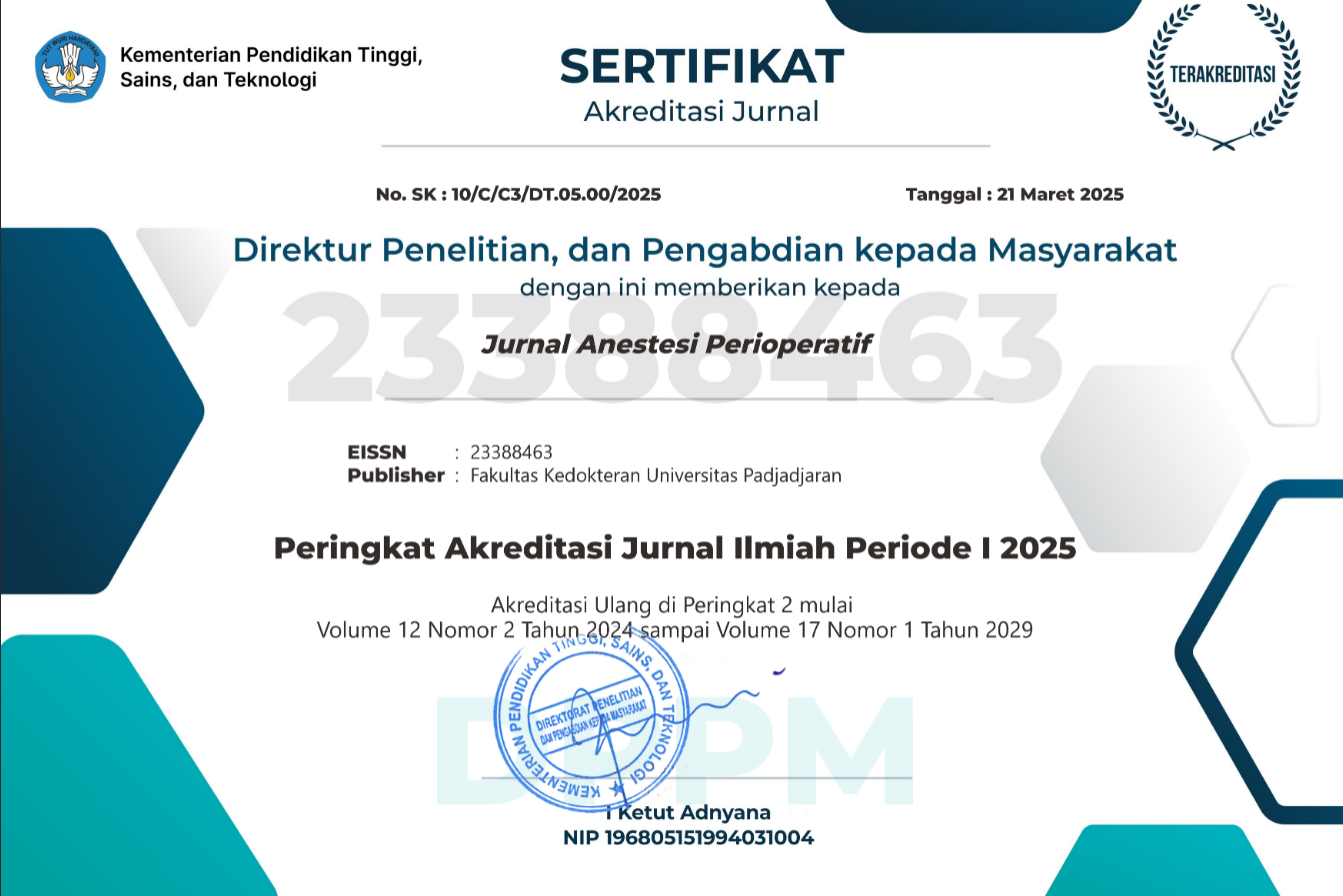Plasmafaresis pada Pasien Status Epileptikus Akibat Ensefalitis Anti-NMDAR di Unit Perawatan Intensif
Abstract
Sejak tahun 2007 penyebab lain ensefalitis diketahui adalah autoimmun selain virus sebagai penyebab terbanyak (69%) dengan angka kematian di dunia 8–18,45%. Ensefalitis anti-NMDAR adalah ensefalitis autoimun akibat reaksi antibodi terhadap antigen membran ekstraseluler, subunit NR1, yaitu reseptor glutamat NMDA di sinapsis susunan saraf pusat. Kasus ensefalitis NMDAR sangat jarang dijumpai, berdasarkan penelitian yang teridentifikasi hanya 1% pasien usia 18–35 tahun yang dirawat di Unit Perawatan Intensif (UPI), namun dengan penatalaksanaan yang tepat dapat meningkatkan prognosis pasien. Pasien laki-laki, usia 36 tahun dikonsulkan ke UPI RSHS setelah 10 hari rawatan di Neuro High Care (NHC) pada bulan Agustus 2019 dengan penurunan kesadaran disertai riwayat kejang berulang dengan diagnosis ensefalitis anti-NMDAR. Kombinasi obat anti-viral, anti-epilepsi, dan metilprednisolon yang diberikan sebelumnya di ruangan tidak memberikan perbaikan klinis bermakna. Selama perawatan di UPI pasien diberikan terapi plasmafaresis dan menunjukkan perbaikan secara signifikan. Bangkitan kejang berulang dapat berupa kejang parsial, kejang generalisata dan status epileptikus. Manifestasi kejang diduga terjadi karena terbentuknya antibodi yang menyerang reseptor glutamat NMDA dengan target utama NR1. The American Society for Apheresis merekomendasikan plasmaferesis sebagai pilihan terapi utama. Simpulan, terapi plasmafaresis dalam tata laksana kasus ensefalitis anti- NMDAR merupakan pilihan tepat karena terbukti efektif dan efisien dalam perbaikan klinis pasien melalui mekanisme penurunan titer antibodi terhadap reseptor NMDA.
Plasmapheresis in Patients of Epilepticus Status Patients Due to
Anti-NMDAR Encephalitis in Intensive Care Units
Since 2007 another known cause of encephalitis is autoimmune other than viruses as the most common cause (69%) with a mortality rate in the world of 8-18.45%. Anti-NMDAR encephalitis (n-Methyl-D-Aspartate receptor) is an autoimmune encephalitis due to an antibody reaction to the extracellular membrane antigen, NR1 subunit, the NMDA glutamate receptor at the synapses of the central nervous system. Cases of NMDAR encephalitis are very rare, based on studies that identified only 1% of patients aged 18-35 years who were treated in the Intensive Care Unit (ICU), but with proper management could improve the patient's prognosis.
Male patient, 36 years old, was admitted to ICU RSHS after 10 days of treatment at Neuro High Care (NHC) in August 2019 with decreased consciousness accompanied by a history of recurrent seizures with a diagnosis of anti-NMDAR encephalitis. The combination of anti-viral, anti-epileptic, and methylprednisolone drugs given previously at NHC did not provide clinically meaningful improvement. During treatment at ICU, patients were given plasmafaresis therapy and showed significant improvement. Recurrent seizures can be partial seizures, generalized seizures and status epilepticus. Seizure manifestations are thought to occur due to the formation of antibodies that attack NMDA glutamate receptors with the main target NR1. The American Society for Apheresis recommends plasmapheresis as the main therapeutic choice. In conclusion, plasmafaresis therapy in the management of anti-NMDAR encephalitis cases is the right choice because it is proven effective and efficient in the clinical improvement of patients through the mechanism of decreasing antibody titers to NMDA receptors.
Keywords
Full Text:
PDFReferences
Tunkel A.R, Glaser C.A, Bloch KC, Sejvar JJ, Marra CM, Roos KL, dkk. The management of encephalitis: clinical practice guidelines by the infectious diseases society of America. Clin Infect Dis. 2008;47:303–27.
Gu Y, Zhong M, He L, Li w, Huang Y Liu J, dkk. epidemologi of antibody-positive autoimmune encephalitis in southwest china: a multicenter study. Frontiers in Imunology 10:2611 [Online Jurnal] November 2019 [diunduh 10 Januari 2020]
Dalmau J, Lancaster E, Hernandez EM, Rosenfeld MR, Gordon RB. Clinical experience and laboratory investigations in patients with anti- NMDAR encephalitis. Lancet Neurol. 2011;10(1):63–74.
Ferdinand P. Mitchell L. Anti NMDA receptor encepahlitis. J Clin Cell Immunol. 2012;S10:007.
Kayser MR, Dalmau J. Anti NMDA receptor encephalitis in psychiatry. Curr Psychiatry Rev. 2011;7(3):189–93.
Gable MS, Gavali S, Radner A, Tilley DH, Lee B, Dyner L, dkk. Anti-NMDA receptor encephalitis: report of ten cases and comparison with viral encephalitis. Eur J Clin Microbiol Infect Dis. 2009; 28:1421–9.
Jones KC, Benseler SM, Moharir M. Anti-NMDA receptor encephalitis. neuroimag Clin N Am. 2013;23:309–20.
Mann A, Machado NM, Mazin AH, Silver K, Afzal KI. A Multidisciplinary approach to the treatment of Anti NMDA Receptor antibody encephalitis: a case and review of the literature. J Neuropsychiatry Clin Neurosci. 2012;24:2.
Bakpa OD, Reuber M, Irani SR. Antibody associated epilepsy: clinical features, evidence for immunotherapies and future researceh question. Seizure. 2016;41:26–41.
Graus F, Titulaer MJ, Balu R, Benseler S, Bien CG, Cellucci T, dkk. A clinical approach to diagnosis of autoimmune encephalitis. Lancet Neuro. 2016;15(4):391–404.
Barry H, Byrne S, Barrett E, Murphy K.C, Cotter D.R. Anti-N-Methyl-D-aspartate receptor encephalitis review of clinical presentation, diagnosis and treatment. BJ Psych Bulletin. 2015;39:19–23.
Peery HE, Day GS, Dunn S, Fritzler MJ, Prüss H, De Souza C, dkk. Anti-NMDA receptor encephalitis. the disorder, the diagnosis, and the immunobiology. Autoimmunity review. 2012;11(12):863-72.
Ford B, Macdonald A, Srinivasan S. Review anti-NMDA receptor encephalitis: a case study and illness overview. Drugs In Contect. 2019;8:212589.
Lennox BR, Coles AJ, dan Vincent A. Antibody-mediated encephalitis: a treatable cause of schizophrenia. BJ Psych. 2012;200:92–4.
Tsutsui K, Kanbayashi T, Tanaka K, Boku S, Ito W, Tokunaga J, dkk. Anti-NMDA-receptor antibody detected in encephalitis, schizophrenia, and narcolepsy with psychotic features. BMC Psychiatry. 2012; 12:37.
Fridey JL, Kaplan AA. Therapeutic apheresis (plasma exchange or cytapheresis): indications and technology. Dalam: Silvergleid AJ, Tirnauer JS, penyunting. 2017. Tersedia dari: www.uptodate.com/contents/therapeutic-apheresis-plasma-exchange-or-cytapheresis-indications-and-technology.
Kerridge I, Collins C, Isbister JP. Therapeutic plasma exchange and intravenous immunoglobulin immunomodulatory therapy. Dalam, Oh’s intensive Care Manual. Edisi ke-7. 2014. hlm. 993.
Schwartz J, Padmanabhan A, Aqui N, Balogun RA, Connelly-Smith L, Delaney M, dkk. Guideline on the use of therapeutic apheresis in clinical practice–evidence based approach from the writing committee of the American society for apharesis : the seventh special issue. J Clin Apher. 2016;31:149–338.
DOI: https://doi.org/10.15851/jap.v8n1.1978
Article Metrics
Abstract view : 4668 timesPDF - 9863 times
This Journal indexed by

JAP is licensed under a Creative Commons Attribution-NonCommercial 4.0 International License
View My Stats



